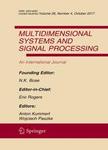版权所有:内蒙古大学图书馆 技术提供:维普资讯• 智图
内蒙古自治区呼和浩特市赛罕区大学西街235号 邮编: 010021

作者机构:Razi Univ Comp Engn Dept Kermanshah Iran
出 版 物:《MULTIDIMENSIONAL SYSTEMS AND SIGNAL PROCESSING》 (多维系统和信号处理)
年 卷 期:2022年第33卷第4期
页 面:1409-1444页
核心收录:
学科分类:0808[工学-电气工程] 0809[工学-电子科学与技术(可授工学、理学学位)] 08[工学] 0812[工学-计算机科学与技术(可授工学、理学学位)]
主 题:Texture classification Feature extraction Local binary pattern Noise tolerance
摘 要:Local binary pattern (LBP) is an efficient texture descriptor with increasing applications in machine vision. Notwithstanding the great ability of LBP in revealing texture features of natural images, this descriptor is sensitive to noise, and its accuracy is reduced when applied to noisy images. The two important noise sensitive components in computing LBP, which affect the generated binary patterns, are the central pixel value and the neighboring pixels values, which are used for thresholding. This paper proposes a noise robust texture descriptor that applies a novel mechanism for potential noisy central pixel detection and correction. Moreover, the proposed descriptor uses a new sampling method that corrects potential noisy neighboring pixels by replacing them with the median of their various radii neighboring pixels, which are located in a new arc-shaped structure. Since the proposed median arc center corrected binary pattern (MACCBP) uses pixels related to different radii patterns for code generation, both macro and micro structures participate in thresholding. Hence, performance is increased in both noisy and noiseless environments. Furthermore, the MACCBP applies the idea of completed LBP and extracts magnitude and center information in conjunction with the sign to achieve more noise robustness and classification accuracy. The proposed descriptor is extensively examined in noisy and noise-free experiments using Outex, UIUC, UMD and CUReT datasets. The experimental results show that MACCBP achieves high classification accuracy in the experiments with original images of the datasets, and when additive salt and pepper noise, Gaussian white noise and Gaussian blur are applied to the test images. The MACCBP is compared with its well-known state-of-the-art counterparts in terms of classification accuracy in the experiments. The results obtained from numerous and extensive tests demonstrate that the proposed descriptor is notably superior to its competitors in noisy